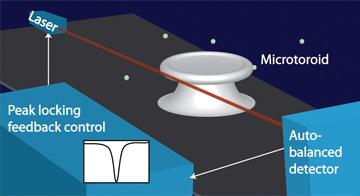 In the FLOWER detection scheme, microtoroid optical resonators are used in conjunction with frequency-locking feedback control and balanced detection to improve the signal-to-noise ratio of the system. As a result, single-macromolecule detection becomes possible. [Adapted with permission from J. Su., ACS Photonics 2, 1241 (2015). © 2015, American Chemical Society.]
In the FLOWER detection scheme, microtoroid optical resonators are used in conjunction with frequency-locking feedback control and balanced detection to improve the signal-to-noise ratio of the system. As a result, single-macromolecule detection becomes possible. [Adapted with permission from J. Su., ACS Photonics 2, 1241 (2015). © 2015, American Chemical Society.]
Single-molecule detection is one of the fundamental challenges of modern biology. Such experiments often use labels that can be expensive, difficult to produce and, for small analytes, might perturb the molecular events being studied. We have recently created a biological and chemical sensing system known as a frequency-locked optical whispering evanescent resonator (FLOWER), which can detect single molecules in aqueous solution without the use of labels.1
FLOWER combines microtoroid optical-resonator technology with laser-frequency-locking, balanced-detection and data-processing techniques. Our approach measures the adsorption of individual particles onto a functionalized silica microtoroid by tracking changes in resonant frequency of the microtoroid.
Our work is an improvement over previous scanning systems that continually sweep back and forth over a large frequency range (3.1×104 fm), only occasionally matching resonance. In contrast, FLOWER directly tracks the resonant wavelength location within a narrow and adaptively varied frequency range with a fixed bandwidth of 19 fm. Thus, the system can track discrete signal fluctuations more accurately and quickly, permitting detection of slight and transient events. We can detect small particles of only around 2-nm radius via advances including the use of balanced photodetectors, direct laser frequency modulation (instead of external phase modulation), the use of 24-bit data acquisition cards, and nonlinear post-processing filtering routines.
To date, we have demonstrated detection of single silica nanoparticles 2.5 nm in radius, 15.3k-Da interleukin-2 molecules, ribosomes, exosomes and antibodies. Our results, covering several orders of magnitude of particle radius (100 nm to 2 nm), agree with established model predictions for the frequency shift of the resonator upon particle binding. This confirms that the main contribution of the frequency shift for the resonator upon particle binding is an increase in the effective path length as part of the evanescent field couples into the adsorbed particle.
In addition to high sensitivity, FLOWER has a fast response time and avoids the signal amplification inconsistencies of plasmonic nanoresonators. Furthermore, FLOWER has a large capture area compared with other nanoscale sensors such as cantilevers, nanowires and metallic nanoparticles, making analyte detection events more likely.
We have recently used FLOWER to assay the progression of tumors implanted in mice by detecting low concentrations of tumor-derived exosomes.2 We anticipate that our results will enable many applications, including more sensitive medical diagnostics and fundamental studies of single receptor–ligand and protein–protein interactions in real time.
Researcher
Judith Su, University of Arizona, USA
References
1. J. Su et al. Light Sci. Appl. 5, e16001 (2016).
2. J. Su. ACS Photonics 2, 1241 (2015).
